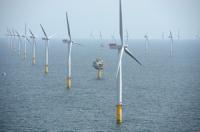-
A First: U.K. Renewables Generate More Electricity than Fossil Fuels
In the third quarter of 2019, the U.K.’s windfarms, solar panels, biomass and hydro plants generated more electricity than the combined output from power stations fired by coal, oil and gas, a new analysis reveals. During the three months of July, August and September, renewables generated an estimated total of 29.5 terawatt hours (TWh), compared with just 29.1TWh from fossil fuels, the analysis shows. This is the first-ever quarter where renewables outpaced fossil fuels since the U.K.’s first public electricity generating station opened in 1882.
-
-
This Technology Replaces Coal Power with Wood Power
A new technology makes it possible to replace coal with eco-friendly wood pellets. As soon as the world stops fueling its power plants with coal, Norwegian technology company Arbaflame is ready to pick up the baton.
-
-
The Myth of U.S. Energy Independence Has Gone Up in Smoke
In response to the massive attack on Saudi Arabia’s oil infrastructure this weekend, U.S. President Donald Trump has trumpeted that America’s new oil abundance cushions the disruption and boosts strategic stocks, arguing that building more oil pipelines will help protect Americans from oil price shocks. Jason Bordoff writes Foreign Policy that in reality, the attack on Abqaiq, the world’s most critical oil facility, is a stark reminder that the United States is not energy independent, nor can it go it alone when it comes to diplomacy in the world’s most critical oil-producing region.
-
-
If U.S. Claims of How the Saudi Oil Attack Went Down Are True, Then the Failure to Prevent It Is a Huge Embarrassment
It has yet to be definitively established how the massively disruptive attacks this past weekend on a crucial Saudi oil facility took place. The version of events being advanced by U.S. officials, however — that most of the damage was from cruise missiles launched from Iran — raises the embarrassing question of why the U.S. military was unable to do anything about it. the airspace around Iran and Saudi Arabia is some of the best-defended and most intensively monitored on earth, thanks to the decades-long buildup of U.S. assets there. But on Saturday those defenses failed to prevent what U.S. officials have said were at least 17 separate strikes. Based on information made public about the strikes, defense insiders were left wondering how the U.S. military had fared so poorly in one of its primary missions in the region.
-
-
Exploring Options for Microreactors in Alaska
For cities in the most isolated regions of Alaska, keeping the lights on is often challenging and almost always expensive. There’s no good way to string power lines over the vast expanses of wilderness that separate individual towns, so instead of one consolidated grid spanning the entire state, Alaskans get their power from a disconnected mishmash of more than 200 microgrids. This is why experts have been exploring whether microreactors might help alleviate some of Alaska’s energy challenges.
-
-
Nuclear Power Offers an Abundant Supply of Low-Carbon Energy. But What to Do With the Deadly Radioactive Waste?
The dilemma of how to manage nuclear waste — radioactive materials routinely produced in large quantities at every stage of nuclear power production, from uranium mining and enrichment to reactor operation and the reprocessing of spent fuel — has taxed the industry, academics and governments for decades. Along with accidents, it has been a major reason for continuing public opposition to the industry’s further expansion despite substantial interest in nuclear power’s status as a low-carbon power source that can help mitigate climate change. The race is on to develop new strategies for permanently storing some of the most dangerous materials on the planet.
-
-
Predicting Earthquake Hazards from Wastewater Injection
A byproduct of oil and gas production is a large quantity of toxic wastewater called brine. Well-drillers dispose of brine by injecting it into deep rock formations, where its injection can cause earthquakes. Most quakes are relatively small, but some of them have been large and damaging. Yet predicting the amount of seismic activity from wastewater injection is difficult because it involves numerous variables. Geoscientists have developed a method to forecast seismic hazards caused by the disposal of wastewater.
-
-
Largest-ever simulation of the Deepwater Horizon spill
In a 600-ft.-long saltwater wave tank on the coast of New Jersey, a team of NJIT researchers is conducting the largest-ever simulation of the Deepwater Horizon spill to determine more precisely where hundreds of thousands of gallons of oil dispersed following the drilling rig’s explosion in the Gulf of Mexico in 2010.
-
-
Coal-fired power plants may affect your drinking water
When you get a drink of water from your fridge or sink, do you think about where that water came from? A new study takes a national look at whether coal-fired power plants are unintentionally affecting drinking water treatment plants.
-
-
Examining the safety of using dispersants in oil spill clean ups
A new study of the Deepwater Horizon oil spill recovery efforts makes a series of recommendations to federal agencies on how to safely clean up after spills.
-
-
Fracking Linked to earthquakes in the Central and Eastern United States
Small earthquakes in Ohio, Pennsylvania, West Virginia, Oklahoma and Texas can be linked to hydraulic fracturing wells in those regions, according to researchers. While relatively rare compared to earthquakes caused by wastewater disposal in oil and gas fields in the central United States, the researchers have identified more than 600 small earthquakes (between magnitude 2.0 and 3.8) in these states.
-
-
New device creates electricity from snowfall
Researchers and colleagues have designed a new device that creates electricity from falling snow. The first of its kind, this device is inexpensive, small, thin and flexible like a sheet of plastic.
-
-
Saving millions of lives by rapidly shifting to renewable energies
Reducing global air pollution can prevent millions of premature deaths according to an international team of scientists. The most significant contribution would be the rapid phasing out of fossil fuels, which is currently being discussed mainly to abate climate change.
-
-
Venezuela announces major energy rationing amid new power outages

Venezuelan President Nicolas Maduro has announced that the government will reduce the length of the country’s workday and keep schools closed as it attempts to ration electricity in the face of continued power cuts.
-
-
Offshore wind energy potential not exploited by U.S. energy companies

When it comes to wind energy, the United States is sitting on a gold mine, so to speak. It’s a moment of untapped potential that, if harnessed properly, could transform the way the U.S. uses energy, one expert says.
-
More headlines
The long view
Trump Is Fast-Tracking New Coal Mines — Even When They Don’t Make Economic Sense
By Katie Myers
In Appalachian Tennessee, mines shut down and couldn’t pay their debts. Now a new one is opening under the guise of an “energy emergency.”
Smaller Nuclear Reactors Spark Renewed Interest in a Once-Shunned Energy Source
By David Montgomery
In the past two years, half the states have taken action to promote nuclear power, from creating nuclear task forces to integrating nuclear into long-term energy plans.
